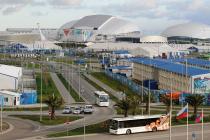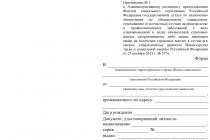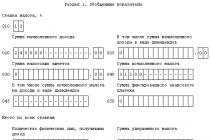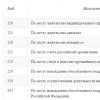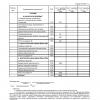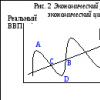Between 1991 and early 1995 central bank Russian Federation pursued a policy of credit restriction. The refinancing rate was increased from 20% as of January 1, 1991 to 210% as of October 15, 1993. In the period from April 29, 1994 to August 24, 1994, the rate was gradually reduced to 130%; on 11/17/94 and 01/06/95, respectively). During the specified period (1991 - early 1995), the Bank of Russia increased the norm required reserves. Thus, as of June 1, 1991, the required reserve ratio was 2%. Gradually raising this ratio, the Bank of Russia from February 1, 1995 introduces a differentiation of required reserve ratios depending on the terms and currency of commercial banks' obligations: for demand accounts and term obligations up to 30 days - 22%, for term obligations of banks from 30 days to 90 days - 15%, for term obligations over 90 days - 10%, for current accounts in foreign currency - 2%.
As a result of these tough measures taken by the main bank on monetary regulation of the economy, the following results were achieved:
Table 1.4.1
during 1991 - 1995
Analyzing the data in the table, we can conclude that the annual value of the consumer price index is significantly higher than the corresponding value of the money supply growth indicator, which indicates that the monetary credit policy aimed at compressing the money supply. Measures on monetary regulation, carried out with the aim of curbing inflation, the goal set for them was realized, as evidenced by the dynamics of the consumer price index.
Since the spring of 1995, the Central Bank of the Russian Federation has been implementing a policy of credit expansion. The refinancing rate was reduced from 195% as of May 16, 1995 to 21% as of October 6, 1997. In the same period, the required reserve ratios change, as evidenced by the data in the table: Table 1.4.2
Change in the norms of required reserves from 1.05.95 to 1.05.97
| Date of change | Reserve requirements depending on the terms of obligations of commercial banks, % |
|||
| required reserve ratio | On demand and up to 30 days | 30-90 days | Over 90 days | For current accounts in foreign currency |
| 1.05.95 | 20 | 14 | 10 | 1,5 |
| 1.05.96 | 18 | 14 | 10 | 1,25 |
| 1.06.96 | 20 | 16 | 12 | 2,5 |
| 1.08.96 | 18 | 14 | 10 | 5 |
| 1.11.96 | 16 | 13 | 10 | 5 |
| 1.05.97 | 14 | 11 | 8 | 6 |
As the data in the table show, the required reserve ratios for ruble liabilities of credit institutions in the analyzed period are somewhat reduced, but for accounts in foreign currency they are significantly - 4 times - increased.
As a result of the implementation of these activities, the following indicators:
Table 1.4.3
Dynamics of the consumer price index and the rate of annual growth in the money supply for the M2 aggregate during 1996-1997
Analyzing the data in the table, we can conclude that the ratio of the dynamics of the consumer price index and the growth rate of the money supply for the M2 aggregate has changed: the growth rate of the money supply exceeded the inflation rate for the analyzed indicator. On the whole, during 1996-1997, the positive trend of declining inflation continues. The situation changes in 1998 as a result of the August crisis. Trying to avert the crisis, the Bank of Russia, as an organ of monetary credit regulation, raises the refinancing rate. Initially, the rate was increased to 28% as of November 11, 1997, then to 42% as of February 2, 1998, after which a chaotic change in the refinancing rate occurs: in the period from July 11, 1997 to August 1, 98, the rate changes 10 times , both upwards and downwards. In the same period, the reserve requirements for funds attracted by banks in foreign currency increased: up to 9% as of November 11, 1997 and up to 11% as of February 1, 1998. Despite the measures taken, the crisis could not be prevented. On August 24, 1998, to mitigate the negative impact of the crisis, the Bank of Russia introduces a single standard for funds attracted by credit institutions in rubles and foreign currency in the amount of 10%. For Sberbank of Russia, the required reserve ratio for borrowed funds in rubles was reduced to 7%, after which, a week later, on September 1, 1998, reserve requirements for borrowed funds in rubles and foreign currency for Sberbank of Russia and credit institutions in which the share of investments in government securities (GKO-OFZ) in working assets is 40% or more, decreasing to 5%; for credit institutions whose share of investments in government securities in working assets is 20-40%, the reserve requirements for attracted funds in rubles and foreign currency are set at 7.5%.
Despite the implementation of these measures, the Bank of Russia failed to prevent an inflationary surge, while the consumer price index for 1998 amounted to 84.4%, the growth rate of the money supply for the M2 aggregate was 20.9%.
In the post-crisis period, the Bank of Russia continues to implement a policy of credit expansion, gradually reducing the refinancing rate. However, at the same time, the main bank of the country raises reserve requirements, as a result of which two instruments of monetary regulation of different directions operate simultaneously, which led to the following results: Table 1.4.4.
Dynamics of the consumer price index and the pace
annual increase in the money supply for the M2 aggregate
during 1999 - 10 months of 2001
Analyzing the data in the table, we can draw the following conclusions: the growth rate of the money supply exceeds the inflation rate based on the consumer price index. With a significant increase in the money supply (55.6% in 1999 and 62.5% in 2000), prices for consumer goods increased by 36.5% and 20.2% respectively. In 2001, the positive dynamics of the decrease in the rate of inflation was noted as well. Consequently, the increase in the total volume of the money supply did not lead to the development of inflationary processes, which also manifests the regulatory role of the country's main bank.
CREDIT RESTRICTATION
Restriction by banks and the state of the size of the loan in order to prevent the leakage of gold reserves abroad, to avoid the collapse of banks and inflationary processes.
Big legal dictionary. 2012
See also interpretations, synonyms, meanings of the word and what is CREDIT RESTRICTION in Russian in dictionaries, encyclopedias and reference books:
- CREDIT RESTRICTATION
- limiting the size of credit by banks and the state in order to prevent the leakage of gold reserves abroad, to avoid the collapse of banks and inflationary ... - RESTRICTION
CREDIT - see CREDIT RESTRICTION ... - CREDIT in the Dictionary of Economic Terms:
RESTRICTION - restriction by banks and the state of the size of the loan in order to prevent the leakage of gold reserves abroad, to avoid the collapse of banks and ... - RESTRICTION in the Dictionary of Economic Terms:
(Latin restrictio - restriction) - 1) restriction of production, sale and export of certain goods carried out by monopolies in order to artificially maintain on ... - CREDIT in the Dictionary of Economic Terms:
SYSTEM - set credit relations existing in the country, forms and methods of lending, banks or other credit institutions organizing and implementing ... - CREDIT in the Dictionary of Economic Terms:
ORGANIZATION NON-BANKING - see ... - CREDIT in the Dictionary of Economic Terms:
ORGANIZATION - entity, which, in order to make a profit as the main goal of its activities, on the basis of special permission(licenses) of the Central Bank ... - CREDIT in the Dictionary of Economic Terms:
MARGIN - the difference between the value of goods fixed in loan agreements and the amount of the loan issued for the purchase ... - CREDIT in the Dictionary of Economic Terms:
LINE - a legally executed obligation of the bank to the borrower to provide him with certain period loans (open credit line) within … - CREDIT in the Dictionary of Economic Terms:
COOPERATION - an association of small commodity producers to meet the needs of its members in a loan. Its funds are formed through share contributions and ... - CREDIT in the Dictionary of Economic Terms:
REVOLVER CARD - see REVOLVER CREDIT CARD ... - CREDIT in the Dictionary of Economic Terms:
CARD - nominal money document; form of payment in which the bank assumes the risk of immediate payment for goods and services of its ... - CREDIT in the Dictionary of Economic Terms:
APPLICATION - application-petition of the client for the issuance of a loan. K.z. is drawn up in any form, in which it is necessary to indicate: the full name of the client, his ... - CREDIT in the Dictionary of Economic Terms:
DISCIPLINE - compliance by borrowers with the rules of lending and obligations arising from the terms of the loan transaction. In case of violation of K.d. credit applied... - CREDIT in the Dictionary of Economic Terms:
DISCRIMINATION - the creation by the creditor of less favorable conditions for obtaining, using or returning borrowed money for some borrowers versus others… - CREDIT in the Dictionary of Economic Terms:
VOINA - enhanced credit incentives for the export of competing goods in a certain … - CREDIT in the Dictionary of Economic Terms:
BLOCCADE - one of the types of economic blockade of a country or a group of countries by other countries or international financial and credit organizations, consisting ... - RESTRICTION in Medical terms:
(lat. restrictio restriction) destruction of foreign deoxyribonucleic acid under the influence of endonucleases ... - RESTRICTION in the Big Encyclopedic Dictionary:
(from late Latin restrictio - restriction) restriction of production, sale and export of goods, carried out in order to raise prices and obtain monopoly profits; … - RESTRICTION
(from late Latin restrictio - restriction), restriction of production, sale and export, carried out by monopolies and especially international cartels in order to drive up prices ... - RESTRICTION in the Modern Encyclopedic Dictionary:
- RESTRICTION
(from late Latin restrictio - restriction), restriction of production, sale and export of goods, in order to increase prices, restriction by banks and the state of sizes ... - RESTRICTION in the Encyclopedic Dictionary:
and, well. 1. eq. Limiting the production, sale and export of goods in order to increase their value and obtain high profits. 2. … - RESTRICTION
RESTRICTION (from late Latin restrictio - restriction), restriction of production, sale and export of goods, carried out in order to raise prices and obtain monopoly ... - CREDIT in the Big Russian Encyclopedic Dictionary:
CREDIT SYSTEM, a set of forms and methods of credit within one country; a set of credit institutions of the country (banks, insurance companies, pawnshops and ... - CREDIT in the Big Russian Encyclopedic Dictionary:
CREDIT REFORM, a set of state. acts aimed at changing the credit ... - CREDIT in the Big Russian Encyclopedic Dictionary:
CREDIT CARD, nominal den. a document issued by a credit institution that certifies the identity of the owner of the bank account and gives him the right to purchase ... - CREDIT in the Big Russian Encyclopedic Dictionary:
CREDIT BLOCKADE, refusal to.-l. state-va or international. finance. org-tion to provide loans to a country or group ... - RESTRICTION in the Full accentuated paradigm according to Zaliznyak:
restriction, restriction, restriction, restriction, restriction, restriction, restriction, restriction, restriction, restriction, restriction, restriction, restriction, restriction, restriction, restriction, ... - RESTRICTION in the New Dictionary of Foreign Words:
(Latin restrictio restriction) 1) restriction of production, sale and export, carried out by capitalist monopolies in order to inflate prices for goods and ... - RESTRICTION in the Dictionary of Foreign Expressions:
[ 1. restriction of production, sale and export, carried out by the capitalist monopolies with the aim of inflating the prices of goods and obtaining high profits; … - RESTRICTION
restriction, restrictase, ... - RESTRICTION in the Dictionary of the Russian Language Lopatin:
restriction, ... - RESTRICTION in the Complete Spelling Dictionary of the Russian Language:
restriction, ... - RESTRICTION in the Spelling Dictionary:
restriction, ... - RESTRICTION in Modern explanatory dictionary, TSB:
(from late Latin restrictio - restriction), restriction of production, sale and export of goods, carried out in order to raise prices and obtain monopoly profits; … - RESTRICTION
and. 1. Reduction or reduction in the level of loans central bank countries to commercial banks in order to curb inflation. 2. Limitation of production, sales ... - NON-BANK CREDIT ORGANIZATION in the One-volume large legal dictionary:
- credit organisation which has the right to exercise individual Bank operations. permissible combinations of banking operations for n.c.o. established by the Central Bank of the Russian Federation ... - NON-BANK CREDIT ORGANIZATION
- a credit institution that has the right to carry out certain banking operations. Permissible combinations of banking operations for N.c.o. set by the Central Bank... - CREDIT CARD in the Dictionary of Financial Terms:
a form of settlement in which banks assume the risk of immediate payment for goods and services purchased by their depositors. The bank loan is repaid... - FINANCIAL COMPANY in the One-volume large legal dictionary:
- a credit institution that performs certain banking operations. in international practice f.c. specialize in providing consumer loans, loans to small and medium ... - FINANCIAL COMPANY in the Big Law Dictionary:
- a credit institution that performs certain banking operations. In international practice, F.K. specialize in providing consumer loans, loans to small and medium … - SYSTEM in the Dictionary of Economic Terms:
CREDIT - see CREDIT ...
(from lat. creditum - loan, debt), economic relations between different individuals, social groups and states arising from the transfer of value in ...- COOPERATIVE MOVEMENT in big Soviet encyclopedia, TSB:
movement, social and economic activity aimed at the creation and development of cooperatives (consumer, credit, production, supply and marketing, housing, etc.). The rise of the cooperative... - BANKS (ECONOMIC) in the Great Soviet Encyclopedia, TSB:
special economic institutions that carry out: accumulation Money and savings, granting a loan, conducting cash settlements, issuing certain types of money into circulation, ... - ENZYME in the dictionary of Synonyms of the Russian language:
amidase, amylase, aminopeptidase, protein, gastricin, hydroxylase, hydrolase, glycolidase, dehydrase, dehydrogenase, desmolase, diastase, zymase, isomerase, isoenzyme, invertase, invertin, kallikrein, carbonic anhydrase, carbohydrase, ... RESTRICTIVE in the Big Modern Explanatory Dictionary of the Russian Language:
adj. 1. ratio with noun. restriction associated with it 2. Inherent to restriction, characteristic of it. 3. Limiting, enclosing. ott. …
The monetary policy of the state is a set of actions taken by the state in the field of regulation monetary circulation and credit.
The main instruments of monetary policy are:
1. operations on open market, i.e., transactions with government bonds (buying them from banks and the public leads to an increase in money in circulation; selling them to banks and the public reduces the amount of money supply);
2. changes in the reserve norms of commercial banks (an increase in reserve norms leads to a decrease in the amount of money in circulation; a decrease in required reserves increases the amount of money);
3. changes in the discount rate (accounting or discount policy), i.e., the interest rate at which central banks collect payments on loans to commercial banks (an increase in the rate limits the money supply; a decrease reduces it).
In addition, direct regulation by the state of the interest rate and the establishment of lending limits for commercial banks are applied.
Monetary policy is the main instrument of state regulation, according to economists of the monetarist school. This direction was formed as a kind of protest against Keynesianism, because monetarists consider money to be the main tool for influencing the economy, which is practically not present in numerous Keynesian models. The ideological sources of monetarism must be sought "in the quantity theory of money, on which the classical monetary theory was based"1.
According to M. Friedman, the leader of the monetarists, monetary regulation has a significant impact on the cyclical nature of economic processes, and this impact manifests itself with a certain time lag. Thus, fluctuations in the money supply lead to both "peaks" of the cycle, which are late by 16 months, and to crises, which are one year late.
M. Friedman recommends completely abandoning a consistent monetary policy, which still leads to cyclical fluctuations, and sticking to the tactics of constantly increasing the money supply, and empirically, the American scientist came to the conclusion that the optimal growth of money in the economy should be 4% per year.
For this rule to work, according to M. Friedman, it is required:
1) determine the stock of money to which it refers;
2) establish how the growth rate should be determined;
3) establish what assumptions need to be made for intra-annual or seasonal changes.
One of the reasons for the crisis in the Kazakh economy in the early 90s. many authors consider attempts to import certain monetarist constructions onto Kazakhstani soil, for example, a tight monetary policy aimed at combating inflation and budget deficits. However, supporters of the implementation of this model in Kazakhstan did not take into account the lack of congruence between Western and national economy with its specific regional, industry and technological features.
The main types of monetary policy are:
1) credit expansion (policy of cheap money) - a policy aimed at stimulating credit relations in the country and money issue;
2) credit restriction(policy of expensive money) -- limiting emission and lending.
1. The policy of cheap money is used in the context of a cyclical decrease in output and rising unemployment. The central bank is buying valuable papers(bonds, treasury bills) from the population and commercial banks, lowers the reserve ratio and lowers the discount rate of interest (or the refinancing rate, that is, the rate at which National Bank collects payments on loans issued to commercial banks).
As a result of these measures, the so-called transmission (transmission) mechanism is activated, leading sequentially to:
1) an increase in the money supply;
2) falling interest rates of commercial banks;
3) growth of investment expenses of enterprises;
4) increase real net national product.
credit expansion also leads to the inclusion of the transmission at the level international relations countries. Sequentially happens:
1) reduction in demand for the national currency abroad;
2) impairment national currency;
3) increase in net exports.
2. Dear money policy applied in a growth environment general level prices. The central bank sells securities, while increasing the reserve ratio and the discount rate. As a result, the money supply decreases, the interest rates of commercial banks increase, the volume of investments of enterprises decreases, and the rise in prices decreases.
Credit restriction at the international level leads to an increase in demand for the national currency abroad, an increase in the value of the national currency and a decrease in net exports.
The effectiveness of credit expansion and restriction depends on the following components:
a) on the speed of decision-making by the central bank (as a rule, decisions to change fiscal policy adopted by Parliament and debated for a long time);
b) isolation of central bankers from the pressure of lobby groups.
In general, the main objectives of monetary policy can be considered1:
1. increase in real GDP;
2. lowering the unemployment rate;
3. price stabilization;
4. achieving the stability of the balance of payments.
The monetary policy of the Central Bank is a set of measures aimed at changing the money supply in circulation, the volume of loans, the level of interest rates and other indicators of money circulation and the loan capital market. Its goal is to regulate the economy by influencing the state of the aggregate cash flow, it includes cash money supply in circulation and non-cash money in bank accounts.
Money circulation is regulated by the Central Bank in the process of implementing credit policy, expressed in credit expansion or credit restriction. The credit expansion of the Central Bank of the Russian Federation increases the resources of commercial banks, which, as a result of loans issued, increase the total amount of money in circulation. Credit restriction entails limiting the ability of commercial banks to issue loans and thereby saturate the economy with money.
Basic Tools monetary policy of the Central Bank of the Russian Federation.
The instruments of credit expansion or restriction are the discount rate of the Central Bank and some non-economic measures.
The official discount rate is the interest on loans used by the Central Bank when lending to commercial banks.
Determining the size of the discount rate is one of the most important aspects credit monetary policy, and the change in the discount rate is an indicator of changes in the field of monetary regulation. The size of the discount rate usually depends on the level of expected inflation and at the same time has an impact on inflation. big influence. When the Central Bank of the Russian Federation intends to ease or tighten monetary policy, it lowers or raises the discount (interest) rate.
When regulating the total amount of money in circulation, the Central Bank of the Russian Federation performs the following functions:
- - open market operations,
- - refinancing of banks;
- - currency regulation;
- - cash management;
- - reservation of money of commercial banks by depositing in the Central Bank of the Russian Federation.
Open market operations are purchase and sale Central bank of valuable government papers primarily bonds and other liabilities. The issuer of securities is the Government represented by the Ministry of Finance. The Central Bank of the Russian Federation acts as the main dealer and agent for servicing the public debt.
If the Central Bank buys securities from commercial banks, it transfers money to their correspondent accounts. As a result, the lending capacity of banks increases, they begin to issue loans, which in the form of real non-cash money are included in the sphere of monetary circulation, and, if necessary, are transformed into cash. If the Central Bank sells securities, then commercial banks from their correspondent accounts they pay for such a purchase, thereby reducing their credit opportunities associated with the issue of money.
Refinancing of commercial banks
Under Refinancing of banks refers to the provision of a loan by the Central Bank of the Russian Federation to commercial banks through credit auctions, the provision of a pawnshop loan and a rediscounted loan.
The purpose of refinancing is to influence the state of the monetary sphere. Performing the function of refinancing, the Central Bank acts as a bank of banks.
Pawnshop credit - a form of refinancing in which the Central Bank of the Russian Federation provides loans secured. Unlike loans secured by real estate, pawnshop transactions are secured loans. movable property. The subject of collateral is reliable securities quoted on the stock exchange. Loans are issued within a certain part of their market value, because a fall in the exchange rate is possible. Along with government obligations bills of exchange may be accepted as collateral. The Central Bank of the Russian Federation establishes for the whole country and for each Main Territorial Administration ( national bank) Lombard loan limit.
Currency regulation. Efficient system currency regulation is foreign exchange intervention. The Central Bank of the Russian Federation intervenes in operations on foreign exchange market for the purpose of influencing the ruble exchange rate by buying or selling foreign currency. To increase the exchange rate of the ruble, the Central Bank of the Russian Federation sells foreign currency, to reduce, buys foreign currency in exchange for national.
The monetary policy of the Central Bank of the Russian Federation is an integral part state regulation economy; this is a set of monetary policy measures aimed at regulating the volume of loans, the level of interest rates and other indicators of the loan capital market. Its goal is to regulate the economy by influencing the state of money circulation and credit. The Central Bank in conducting monetary policy uses a set of tools that can be classified:
- - according to the form of influence: direct and indirect;
- - by objects of influence: on the supply of money and on the demand for money;
- - by the nature of the regulated parameters: quantitative and qualitative.
All of these methods are used in unified system and, in turn, are divided into two groups:
- - general - affecting the loan capital market as a whole;
- - selective (selective) - designed to regulate specific types of credit or lending to individual industries, large firms.
Common methods include: accounting policy, or the policy of regulating interest rates of the Central Bank; open market operations, or purchase and sale of government securities; change in the norms of required reserves of banks.
Selective methods include: setting quantitative parameters for loans to priority sectors; creation of special specialized financial and credit lending institutions priority industries at lower interest rates and enjoying benefits in the rediscount of bills in the Central Bank; Spread different kind benefits for credit institutions that provide loans to priority sectors of the economy.
Policy of quantitative credit restrictions - method of credit regulation - quantitative restriction of the amount of loans issued. Unlike the methods discussed above, it is a direct way to influence the activities of banks. Credit restrictions lead to the fact that enterprises - borrowers find themselves in an unequal position. Banks tend to lend to their regular customers, and small and medium-sized firms tend to fall prey to this policy. Achieving with the help of this policy of containment of the money supply, the state contributes to a decrease in business activity.
"Cheap money" policy:
- 1) the Central Bank must purchase securities from the population and commercial banks;
- 2) it is necessary to lower the discount rate;
- 3) it is necessary to make changes to the legislation related to the reduction of the reserve norm.
As a result of the measures taken, excess reserves commercial banks, because they are the basis for increasing the money supply to commercial banks through lending. The money supply in the country increases. An increase in the money supply will lower the interest rate, causing an increase in investment and an increase in net national product. Objective: to make credit cheap and affordable to increase total spending and employment.
"Dear Money" Politics. In a situation where the economy is faced with excessive spending, gives rise to inflationary processes, the Central Bank should try to reduce general expenses by limiting or reducing the money supply. To solve this problem, it is necessary to reduce the reserves of commercial banks as follows:
- 1) the Central Bank must sell government bonds on the open market to cut the reserves of commercial banks;
- 2) raising the discount rate to reduce the interest of commercial banks to increase their reserves by borrowing from the Central Bank. As a result, banks find that their reserves are too small; the current account is too large in relation to their reserves. In order to meet the reserve requirement for insufficient reserves, banks should maintain their current accounts by refraining from issuing new loans after the old ones have been paid off. As a consequence, the money supply will contract, causing the rate of interest to rise, and the rise in the interest rate will reduce investment, altering spending and curbing inflation.
Monetary policy is a set of measures in the field of monetary circulation aimed at changing monetary credit.
Its main goal is to regulate the economic situation by influencing the state of credit and money circulation. Monetary policy has 2 directions:
1. Credit expansion- aimed at stimulating credit and money emission.
2. Credit restriction- their containment and limitation.
In the context of falling production and increasing unemployment, the Central Bank is trying to revive the conjuncture by expanding credit and lowering the rate of interest. If there is an increase in prices, "stock market fever", an increase in disproportions in the economy, then credit restrictions, an increase in%, and emission containment are applied.
Monetary regulation is carried out in several directions:
1) state control over banking system(in order to strengthen the liquidity of banks, i.e. their ability to cover the requirements of depositors in a timely manner);
2) public debt management. In the context of the budget deficit and the growth of public debt, the influence of state loan to the capital market. To do this, the Central Bank buys and sells government bonds, changes the price of bonds, the conditions for their sale;
3) volume control credit operations and money emission with the aim of influencing economic activity.
When conducting monetary policy, the Central Bank uses a set of tools that can be classified:
By the form of impact (direct and indirect);
By objects of influence (supply of money and demand for money);
By the nature of the regulated parameters (quantitative and qualitative).
All these methods are used in a single system.
Monetary policy methods are divided into 2 types:
1. General - affect the loan capital market as a whole.
2. Selective - designed to regulate specific types of credit or lending to certain industries).
1) accounting (discount) policy. It has been used since the middle of the 19th century. The discount rate is the interest on loans that the Central Bank provides to the CB, or a discount when discounting bills of CB.
An increase in the interest rate (“dear money” policy) leads to a reduction in commercial bank borrowing. This makes it difficult to replenish bank resources, leads to higher interest rates, and a reduction in credit operations. It is carried out in order to combat inflation. Lowering the rate (policy of "cheap money") leads to an increase in credit and money supply. It is carried out in case of a decline in production;
2) open market operations consist in the sale or purchase of the Central Bank from commercial banks of government securities, bank acceptances and other credit obligations at a market or pre-announced rate.
The initiator of these operations is the state. In order to prevent inflation, securities are sold. At the same time, their profitability should be higher than that of other assets;
3) reserve norms (requirements) is a part bank deposits and other liabilities that must be kept in an account with the Central Bank. This stock of CBs is not allowed to be used to carry out their operations.
Through the regulation of the reserve requirement, the state increases or decreases the total money supply in the country. If the norms increase by 2 times, then CBs will be forced to reduce credit emission. In addition, this will force the CB to reduce current accounts and direct part of the funds to increase reserves. As a result, the money supply decreases, and the interest on loans increases. All this helps in the fight against inflation. If it is necessary to increase the money supply, then the norms are reduced.
Let the economy face unemployment and falling prices. Therefore, the money supply needs to be increased. To achieve this goal, apply cheap money policy which consists of the following measures:
1. The central bank must purchase securities on the open market from the public and from commercial banks.
2. It is necessary to lower the discount rate.
3. It is necessary to make changes to the legislation related to the reduction of the reserve norm.
As a result of the measures taken, the excess reserves of the commercial banking system will increase. Since excess reserves are the basis for increasing the money supply to commercial banks through lending, it can be expected that the money supply in the country will increase. An increase in the money supply will lower the interest rate, causing an increase in investment and an increase in the gross national product. The objective of this policy is to make credit cheap and easily available in order to increase aggregate spending and employment.
In a situation where the economy is faced with excessive spending, which gives rise to inflationary processes, the Central Bank should try to reduce overall spending by limiting or reducing the money supply. The policy is being expensive money" . It is necessary to reduce the reserves of commercial banks. This is done as follows:
1. The central bank should sell government bonds on the open market in order to cut the reserves of commercial banks.
2. It is necessary to increase the reserve ratio, which automatically frees commercial banks from excess reserves.
3. Increase the discount rate to reduce the interest of commercial banks to increase their reserves by borrowing from the Central Bank.
As a result of the dear money policy, the banks find that their reserves are too small to meet the legally prescribed reserve ratio, that is, their current account is too large in relation to their reserves. Therefore, in order to meet the reserve requirement for insufficient reserves, banks should keep their current accounts by refraining from issuing new loans after the old ones are paid off. As a result, the money supply will contract, causing the rate of interest to rise, and the rise in the interest rate will reduce investment, reducing aggregate spending and curbing inflation. The purpose of this policy is to restrict the money supply, that is, to reduce the availability of credit and increase its costs in order to lower costs and contain inflationary pressures.
The selective methods of monetary policy include:
Control by certain types loans;
Regulation of risk and liquidity of banking operations.
Establishment of quantitative parameters for loans to priority sectors;
Establishment of special credit and financial institutions that lend to priority sectors at lower interest rates and enjoy benefits when rediscounting bills at the central bank;
Distribution of various kinds of benefits to credit institutions that provide loans to priority sectors of the economy.
| Previous |



